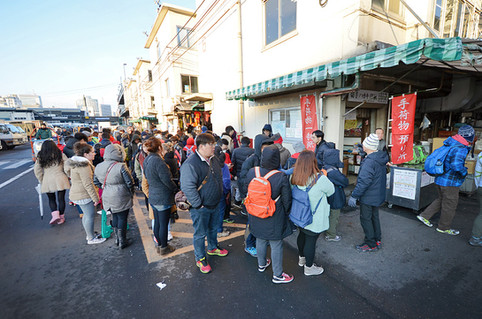The Return of Tsukiji Fish Market


In my last trip, I had innocently arrived just half an hour before the first auction started at 5.25am. After some research, many travellers had advised that we should reach at 3am to guarantee yourself a place in the queue.
I managed to wake up at 2.45am after much struggle. Got onto a cab at 3.15am and reached Tsukiji at 3.40am. It should take around 20 minutes by cab from Shinjuku area, and should cost about 4,000¥. Do inform the taxi driver that you are going to the Kachidoki Gate entrance (beside Kachidoki Bridge) to avoid walking around the market perimeter in the cold morning, and potentially losing a few precious positions in the queue.
When I arrived at the Kachidoki gate at 3.40am, I was already three-quarter down the queue in the second group! So I guess 3am was indeed the time when many would have arrived and started queuing.



The maximum number of visitors allowed per day into the auction is 120, which will be divided into 2 groups of 60 persons each at 5.25am and 5.50am. The first group will be given yellow-coloured vests and the second in blue. Put on your vest at all times even if it doesn't match your look for the day. It is a vest that you should be proud of!
Everyone was ushered into the waiting room at around 3.45am and to spend the next two hours in meditation. There is no leather sofa or lounge chair, no cocktail bar or Nespresso machine. Most would sit or lie on the floor. Over two hours on the floor isn't going to be easy for most of us, some prior yoga training would be useful. Do consider bringing something to keep yourself occupied, like a book, PSP, MP3 player, etc. Some even brought a small foldable stool.







Catch the auction in action below:






The queue for Sushi Dai continued to build-up at 7.15am.































Ueno Park

















TIPS ON TSUKIJI FISH MARKET:
Reach by 3am if you want to be 100% sure to get a place into the tuna auction. Make sure you're at the Kachidoki Gate entrance (beside Kachidoki Bridge).
Reaching at 3.30am would likely get you into the second group of the 120 people.
From my experience in this trip, reaching at 3.45am would likely end you up in a painful disappointment.
All times above are solely based on my experience in this trip. Make your own judgement.
Bring something to keep yourself occupied in the waiting room, especially if you're bringing children along.
There is a vending machine outside the waiting room. You may wish to prepare some light snacks and beverage, as long as they wouldn't make a mess.
A small foldable stool would also be useful.
No photography allowed when walking between the waiting room and the auction hall. Follow instructions or you'll be scolded. They are very serious as it concerns safety.
Photography and videography are allowed in the tuna auction. But NO flash. Be prepared to get shouted at if that strobe goes off from your camera.
Tsukiji Fish Market will be relocated to a new complex in Toyosu by end 2016, after postponing several times. Visit soon if you wish to see the market and the tuna auction in its original setting and flavour that has been around for 80 years. You'll never know when the authorities would start the relocation if it's going to be in phases.








Comments